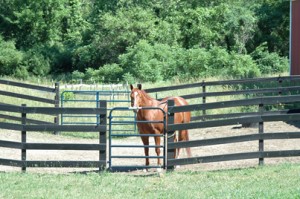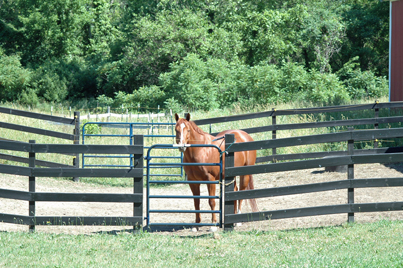
A Good-Horsekeeping Column, By Laurie A. Cerny
About now most horses have been on their pastures for 8-10 weeks. The pasture that looked so beautiful in May is probably looking a little ragged right now.
Your horses have eaten the choice grasses, nibbled around weeds and left a lot of piles in their favorite manure spots. And if you continue to graze your pasture without giving it a break there will be little, if not nothing, for your horses to eat by fall.
Pulling them off of your fields or rotating pastures (if you have more then one) is one of the best management practices for maintaining good, quality grazing areas.
Here are some tips for giving your pasture a summer break:
- If you have other pastures available, simply rotate your fields. If you don’t have another grazing area, consider sectioning off a large pasture into several smaller fields that can be rotated. Rotation is the best way to always have healthy pastures for your horses to graze. Two fields are good; three are even better. Rotate from one field to the next every 4-6 weeks. This way the non-grazed field has several weeks of rest, which will allow for ample re-growth.
- If you don’t have additional pastures, you may need to use a dry lot or a pen to house your horses while you give your pasture a rest. Consider transitioning your horses back over to an all-hay diet for a couple of days before pulling them cold turkey off of the pasture. Likewise, before putting them back on pasture you will need to gradually reintroduce them to a grass diet over a period of 5-7 days.
- Mow the pasture prior to the resting period. Do not mow fields too short; allow at least four inches of growth to remain. This gives grass enough old growth to capture moisture. Mowing not only helps to promote even growth, it’s also a useful tool in weed control (if you mow prior to when weeds have produced seeds, you help to prevent reseeding and spreading of the species). Be careful about mowing just prior to a long, dry spell. Mowing fields extremely short before a dry period or during a drought can do permanent damage.
- Harrow and fertilize pastures. You want to break up manure piles on a regular basis as a way of adding nutrients to the soil and also to dry out these areas as a means to breaking parasitic cycles. If you are getting adequate rain you can also apply a fertilizer. You DO NOT want to apply fertilizer, however, if you’re in a drought or do not expect to get rain within 48 hours or so following application. Doing so can burn your pasture up.
- Be diligent about weed control. Weeds can quickly overtake a pasture and reduce the amount of healthy forage for your horses. Familiarize yourself with the problematic weeds in your area and their growth and reproduction cycles. Some weeds can be eradicated by digging; mowing before they seed can control others. Extremely invasive species, however, require spraying with an herbicide. Make sure that you allow enough time for residuals before putting horses back out on the field.
- Repair damaged or bare spots. Even out areas that have been dug or trampled. If you are able to water the area, over-seed these spots.
- Water or irrigate if possible. If you have a water source, consider watering your pasture (if ample rain is not expected) or at least a portion of it. Only do this if you are able to commit to the watering regimen for the entire resting period (4-6 weeks). Otherwise (and especially if you’re entering a dry or drought conditions) you are better to leave the field alone. Pastures will go semi-dormant under mild drought conditions; this is a better state for the field than if you water haphazardly during a dry period.
- Check your pastures for holes, garbage, dead animals and broken fencing. This is a great time to make fence repairs and to trap any nuisance animals like woodchucks, gophers, skunks, etc.
- Horses can be returned to pastures when there is at least six inches of new growth. Gradually re-introduce them to the pasture (if they have been held in lots and fed hay) for at least five days. Continuing to feed some hay prior to grazing is also a good way to stretch your pastures so that they’re vital well into the fall months.
Laurie Cerny is the editor and publisher of www.good-horsekeeping.com. Her weekly blogs can also be read at good-horsekeeping.blogspot.com. Laurie is also a member of AQHA and ARHA. She lives on a small horse farm in Michigan with her partner, Dennis, and shows Quarter Horses.
